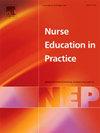培养本科护理学生对解剖学和生理学的理解以融入临床实践:综合文献综述
IF 4
3区 医学
Q1 NURSING
引用次数: 0
摘要
目的批判性地研究和综合同行评审的科学文献,以描述本科护理学生如何为将解剖学和生理学融入临床实践做好准备。解剖学和生理学课程为健康和疾病过程提供科学基础,并为其管理中的所有干预措施提供信息。然而,将解剖学和生理学融入临床实践是护理教育中更具挑战性的方面之一。方法数据从PubMed Central、SCOPUS、ScienceDirect、Medline和EBSCOHOST数据库中检索,包括CINAHL。通过约翰霍普金斯循证评估工具确保质量。数据综合与专题分析同时进行,采用反身性专题分析方法进行。报告调查结果时遵循PRISMA指南。结果本综述共纳入21篇文章,代表了非洲、美洲、亚洲和欧洲11个国家的研究。研究结果表明,护理本科学生将解剖学和生理学整合到临床实践的准备工作是通过以学习者为中心的教学方法、技术的使用、课程改革、实用教育策略、临床环境作为学习环境、跨学科方法以及在实践评估中整合解剖学和生理学。结论临床环境和护理教育机构采取的干预措施应促进人体解剖学和生理学与临床实践的结合。研究结果强调了课程改革的必要性,即整合以学习者为中心的教学和学习策略、技术的使用和额外的评估。我们提倡建立解剖学和生理学与临床实践相结合的框架。本文章由计算机程序翻译,如有差异,请以英文原文为准。
Fostering understanding of anatomy and physiology among undergraduate nursing students for integration into clinical practice: An integrative literature review
Aim
To critically examine and synthesise peer-reviewed scientific literature to describe how undergraduate nursing students can be prepared for the integration of anatomy and physiology into clinical practice.
Background
Anatomy and physiology courses provide a scientific foundation for health and disease processes and inform all interventions in their management. However, integrating anatomy and physiology into clinical practice is one of the more challenging aspects of nursing education.
Design
An integrative literature review
Methods
Data were retrieved from PubMed Central, SCOPUS, ScienceDirect, Medline and EBSCOHOST databases, including CINAHL. Quality was ensured through the Johns Hopkins Evidence-based Appraisal Tool. Data synthesis occurred alongside thematic analysis, which was conducted using a reflexive thematic analysis approach. The PRISMA guidelines were followed for reporting findings.
Results
Twenty-one articles were included in the review, representing studies across 11 countries in Africa, America, Asia and Europe. The findings revealed that preparation for undergraduate nursing students for the integration of anatomy and physiology into clinical practice is through learner-centred teaching and learning approaches, the use of technology, curriculum transformation, practical educational strategies, the clinical setting as a learning context, an interdisciplinary approach and the integration of anatomy and physiology within practical assessments.
Conclusions
Interventions undertaken in clinical settings and nursing education institutions ought to facilitate the integration of human anatomy and physiology into clinical practice. Results underscore the necessity for curriculum reforms to incorporate teaching and learning strategies that centre on the learners, use of technology and additional assessment. We advocate for establishing a framework for integrating anatomy and physiology with clinical practice.
求助全文
通过发布文献求助,成功后即可免费获取论文全文。
去求助
来源期刊

Nurse Education in Practice
NURSING-
CiteScore
5.40
自引率
9.40%
发文量
180
审稿时长
51 days
期刊介绍:
Nurse Education in Practice enables lecturers and practitioners to both share and disseminate evidence that demonstrates the actual practice of education as it is experienced in the realities of their respective work environments. It is supportive of new authors and will be at the forefront in publishing individual and collaborative papers that demonstrate the link between education and practice.
 求助内容:
求助内容: 应助结果提醒方式:
应助结果提醒方式:


